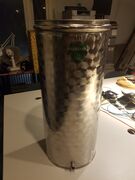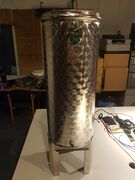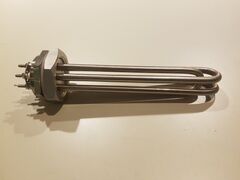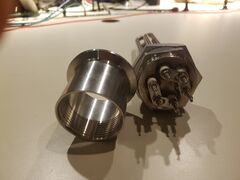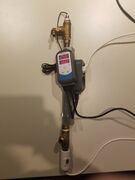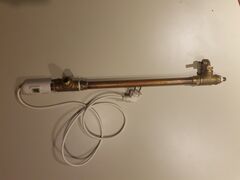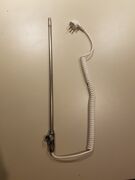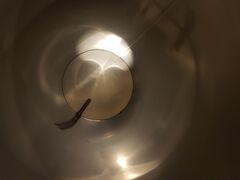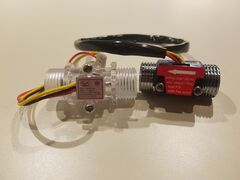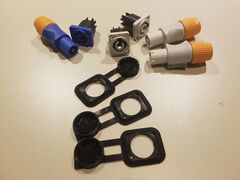Difference between revisions of "Justa-e-brewery"
(→Suggested RIMS design) |
|||
| (5 intermediate revisions by the same user not shown) | |||
| Line 29: | Line 29: | ||
== Suggested RIMS design == | == Suggested RIMS design == | ||
| − | + | ||
* Two vessels of 50 liters; stainless steel 'wine-fermentation' vessels (already present) | * Two vessels of 50 liters; stainless steel 'wine-fermentation' vessels (already present) | ||
* 380Vac 4200Watt heating-element for copper (already present) | * 380Vac 4200Watt heating-element for copper (already present) | ||
| Line 44: | Line 44: | ||
* Lid + Insulating jacket : mash/lauter | * Lid + Insulating jacket : mash/lauter | ||
* Controller-box for mash/Lauter operation: controls PID + Pump | * Controller-box for mash/Lauter operation: controls PID + Pump | ||
| + | |||
| + | == Parts gallery == | ||
| + | <gallery mode='packed-hover'> | ||
| + | File:Justa-e-brewery- 50L Stainless vessel.jpg|50 liter stainless vessel | ||
| + | File:Justa-e-brewery- 50 liter vessel with stand.jpg|50 liter vessel with stand | ||
| + | File:Justa-e-brewery- 380VAC heating-element.jpg|380VAC heating element | ||
| + | File:Justa-e-brewery Detail of 380vac element.jpg|380Vac, connection detail | ||
| + | File:Justa-e-brewery- Small RIMS-tube example with PID controller.jpg|300watt RIMS-tube with PID | ||
| + | File:Justa-e-brewery- 300Watt RIMS-tube without PID.jpg|300Watt RIMS-tube without PID | ||
| + | File:Justa-e-brewery- 600Watt heater for RIMS.jpg|600 watt heating-element for RIMS tube | ||
| + | File:Justa-e-brewery- inside of 50L vessel. Pickup-tube example.jpg|Inside 50L vat. Pickup-tube example shown | ||
| + | File:Justa-e-brewery- flow meters. .jpg|flow meters | ||
| + | File:Justa-e-brewery- thermowell.jpg|Thermowell with DS18B20 | ||
| + | File:Justa-e-brewery- PowerCon connectors.jpg|compact power-connectors | ||
| + | </gallery> | ||
Latest revision as of 01:37, 30 April 2021
Contents
Introduction
There's tons of ways you can brew beer. This page just lists one that happens to fit with the requirements/limitations that we have to deal with regarding brewing at Techinc.
- Safe : No gas, no fire, no ventilation issues (for oxygen purposes)
- Compact: Try to re-use vessels, or eliminate them from design
- Mobile: Cannot stay in one place, must be put in storage
- Automatable: because why not. Also, perhaps allows more people to be able to use it
Design
Experience with similar (RIMS) setup
The design that I've been contemplating for this is a RIMS system. I (Justa) have been brewing with a weird 'hybrid' setup at home that consists of a traditional copper , with gas heating; but the mash/lauter is performed in one vessel with a false bottom that has a 2200Watt heater for getting water up to temp fast, and a 300Watt heater employed inside a RIMS-tube; a pipe with fittings to allows installation of a heating-element along it's length, with wort passing along it. Circulation of wort is performed via a small pump, temperature-control is done via a PID-controller (Inkbird brew-controller in my case).
Suggested for Techinc would be a two-vessel RIMS setup , one mash/lauter tun with a RIMS-tube (say 600 Watt) , and one Copper/HLT that'd have power to pre-heat the mash-water and enough oomph for a rolling boil (say: 4000+ watt)
PRO
One of the great benefits of this setup has been the ability to clear the wort while it is mashing. In the past, I had been using the 2200Watt element to control wort-temp during the mash; tapping some wort off from the tap at the bottom to pass it back in from the top, so as to have the heat be spread more equally. The direct benefit of this seemed to be that I would get my wort to clear far before mash-out. The wort that goes to the copper is almost always entirely devoid of any particles or trub; which has resulted in fewer problems using a heat-exchanger block to cool wort.
After a little while of brewing just with the single 2200Watt element, I decided to try out actually adding a RIMS-tube , including a pump and a PID controller. The result was a 50CM long copper pipe with two T-fittings on either end. A heater-cartridge installed from the bottom. A thermo-well inserted from the top for the PID. Wort exits the vessel via a tap, into a small 12Volt 'Solar-heating hot-water-tank' pump from Ebay. The pump feeds into the bottom of the RIMS-tube. The exit of the RIMS-tube has a small elbow fitted in it with a hose-barb, enabling me to easily direct wort-flow and/or connect a hose to direct wort right into the copper at mash-out. The flow-rate is controllable via the tap and a 12V PWM-regulator that drives the pump. A combination of both is needed.
CON
An issue I currently have is that the PID doesnt know the flow-rate of wort through the pipe. If there is no flow (for any reason), there should be no heating. It has happened that the heater is on full blast but the temp-probe does not see any heat until wort starts boiling in the RIMS-tube up to the thermo-well.. This happens when I forgot to have the tap open far enough or the pump on a high enough speed. Mostly it is just me being stupid , closing a tap quickly without disabling the heater. But this kind of thing can be prevented easily by incorporating a flow-meter (which I already bought , anticipating its use)
Another issue is that I have used a single-way valve for a tap. It'd be good to have a way to direct wort 'sideways', without going through the pump/rims. You could use it to gravity-drain into a copper (instead of pump), perhaps more interestingly, to connect level-glass to so as to see what the level of the liquid in the mash-tun is. This, after all, does not work if there's a pump connected too. Another thing that can be done with this is to use it in case of having a clogged filter-bottom. Connecting a piece of hose and 'squeezing' it will provide a way to push clogging material out of your false-bottom's holes and/or from around the pickup-tube. Especially when having wheat or oats in the mash this seems a useful addition.
Considerations of a HERMS setup
A HERMS setup is designed to have vessels be used for multiple purposes. Especially the sparging process is something that'd be hard to do with a two-vessel RIMS system. You can of course heat the sparging-water in the copper; but then you need to transfer it to another vessel to vacate the copper of liquid before being able to transfer the first run-off from the mash/lauter-tun. This is avoided with the HERMS, but at the cost of a full stainless-steel vessel extra. There might be other advantages of HERMS regarding cleanup and/or the possibility of wort-scorching, though these would need to be investigated.
Suggested RIMS design
- Two vessels of 50 liters; stainless steel 'wine-fermentation' vessels (already present)
- 380Vac 4200Watt heating-element for copper (already present)
- 220Vac 600Watt heating-element for RIMS-tube (already present)
- 1 x stainless tap 1/2" 1-way (copper)
- 1 x stainless tap 1/2" 2-way (Mash/Lauter)
- Stainless pipe + 2x T-fittings, 1/2" (RIMS-Tube)
- Thermowell 1/2" (RIMS-Tube)
- Solar Pump 1/2" 12V (already present)
- Flow-meter, 100C resistant, metal (already present)
- Assorted pipe/hose/barb/fittings , stainless, silicone, stainless, stainless
- Possibility of 'pickup tube' for mash-tun (involves shortening fitting)
- Raised 'filter-bottom' , stainless (mash/lauter tun)
- Lid + Insulating jacket : mash/lauter
- Controller-box for mash/Lauter operation: controls PID + Pump
